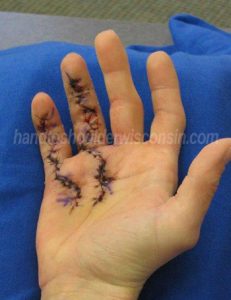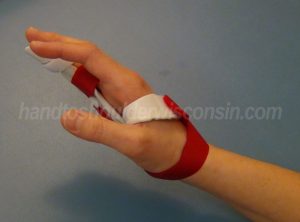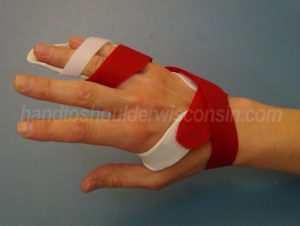Hand to Shoulder Center of Wisconsin has a team of experienced orthopedic doctors and occupational and physical therapists to diagnose and treat Dupuytren’s contracture. If you are looking for hand contracture treatment, contact Hand to Shoulder Center of Wisconsin in Appleton or Green Bay, WI.
What is Dupuytren’s Contraction?
Dupuytren’s contracture, also referred to as Dupuytren’s disease, is a hand disease that promotes thickening of the palm’s deep connective tissue causing fingers to contract. It is a benign condition that typical affects the ring or little finger; small lumps or nodules form in the palm area near the base of the finger. As the condition progresses, additional nodules form beneath the surface of the hand, causing the connective tissue to develop into hard cords or bands; extending into the finger, triggering the finger to contract (bend) into the palm. If left untreated, bending the finger becomes severe, and the ability to straighten the finger ultimately impossible.
Finger contracture may occur suddenly or most often, will progress slowly over time. It typically affects men over the age of 40; however, women and younger individuals are not exempt from this condition.
Dupuytren’s contracture is a disease; surgery will not cure it but will deter it. Once treated, it most likely will take years for the bands to form again and cause contracture of the hand to reappear.
Dupuytren’s Symptoms and Causes of Hand Contracture
In a hand contracture condition such as Dupuytren’s, the most common symptom is the inability to straighten one or more fingers. Pain is typically not a symptom, however, the nodules can be sensitive to the touch. As time progresses, contracture of the hand often will spread into the joints of the fingers, causing permanent immobilization of the fingers. If left untreated, this condition will become permanent.
While no precise origin is known for Dupuytren’s contracture, experts have found common risk factors associated with Dupuytren’s:
- A family history of the Dupuytren’s contracture
- Ancestry– Dupuytren’s disease originally came from the Vikings and is seen in a larger number of individuals with Northern European and Scandinavian descent (English, Scottish, French, Irish, Dutch, Danish, Swedish, Norwegian, and Finnish)
- Gender and age
- Heavy smokers are at risk: heavy smokers that abuse alcohol may be at greater risk
- People with diabetes and seizure disorders, such as epilepsy, tend to have a greater risk factor
Dupuytren’s Treatment and Diagnosis
Although many individuals are unaware of Dupuytren’s contracture treatment, the orthopedic hand surgeons at Hand and Shoulder Center of Wisconsin, instruct patients daily on Dupuytren’s treatment options.
A thorough examination is conducted and all prior hand, wrist and arm injuries and conditions are explored. A visual and physical examination of the hand is performed to measure the bending and/or contracture of the hand and fingers.
Dupuytren’s can easily be diagnosed by feeling the nodules and hard cords beneath the skin in the palm side of the hand and fingers. Typically, no further testing is needed.
Non-Surgical and Surgical Treatment
The best course of treatment is determined by the severity of the disease and the inconvenience of the contracture. In non-surgical treatment, early detection and treatment benefits in preventing disability in the hand. Unfortunately, use of splints, ultrasound, or hand therapy have not found to be very effective in slowing the process of this disease.
In recent years, the U.S Food and Drug Administration (FDA) approved a new injectable drug call Xiaflex. It is a non-surgical, in-office procedure, where the Xiaflex is injected into the hardened cords formed by the disease. The main function of the Xiaflex drug is to weaken and dissolve the diseased tissue, enabling the patient to “break apart” the hardened cord. A 48 to 72 hour follow-up appointment is generally scheduled to evaluation the progress. If the hardened cord has not yet broken apart, our physician may inject a numbing agent to the area and stretch the finger to break apart the hardened cord. This treatment is safe and effective. However, some side effects may occur; due to the newness of the drug, long term effects are being measured.

Figure 1: Post Surgical
If surgery is recommended, Dupuytren’s surgery patients have three options:
- Open fasciotomy – a local anesthetic is given and the skin is cut open. The surgeon is able to locate the hardened tissue and the tissue is released (cut). The surgical site is stitched together (Fig. 1).
- Needle aponeurotomy – a local anesthetic is given and a fine-tipped needle is inserted into the skin over the contracture. The needle is moved back and forth over the hardened tissue in a saw-like motion to cut the hardened tissue apart. Depending on the location and the severity of the contracture, this procedure may not be advised.
- Open fasciectomy – general or regional anesthetic is given and the skin is cut open. The hardened tissue is removed; skin grafting may be required to seal the wound. Because this is an extensive surgery, risk of complications are slightly higher.

Figure 2: A fabricated custom splint is worn to maintain extension of the digits.
In surgical cases, rehabilitation services are typically advised by your surgeon to encourage effective results. A physical or occupational therapist will fabricate a custom splint to maintain your involved digits in an extended position (Fig. 2-3). This splint is typically worn at night for 3 months after the procedure. If needed, the therapist will work with you on a hands-on treatment plan to aid in the strengthening and healing process. Rehabilitation can sometimes take 4 – 6 weeks or more.

Figure 3: A fabricated custom splint is worn to maintain extension of the digits.
If Dupuytren’s contracture surgery is necessary, insurance benefits are verified by the Central Scheduling Department at Hand to Shoulder Center of Wisconsin to determine your best insurance benefit options. All surgeons perform surgery at Woodland Surgery Center, adjacent to Hand to Shoulder Center of Wisconsin in Appleton and have surgical privileges at the three local Fox Valley, WI hospitals.